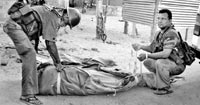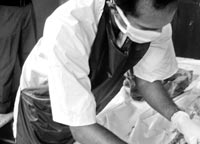|
Post-mortem
on the post mortems
Expert asks why post-tsunami Disaster
Victim Identification (DVI) process was not followed
By Kumudini Hettiarachchi
Mid-October has been set as the target
time-frame to exhume the 15 bodies of the 17 NGO workers
who were killed, by as yet unidentified persons, in
Mutur in early August, following the cloud of mystery
surrounding their deaths and serious allegations of
lack of transparency.
As soon as the security forces give
their clearance these bodies will be exhumed, brought
to Colombo and a joint team of local and foreign forensic
experts will conduct detailed postmortem examinations
on all 17 bodies, The Sunday Times learns. The two bodies
already exhumed on September 14 are under refrigeration
at the office of the Colombo Judicial Medical Officer
(JMO).
 |
| Security forces personnel wrapping
the body of an NGO worker after the postmortem examination
|
Claims of “inadequate postmortems”
performed on these bodies on August 8 could have been
prevented if the system of disaster victim identification
(DVI) put into place by the JMOs of this country was
activated by the authorities, stresses Dr.Clifford Perera,
Coordinator of the Working Group of JMOs for DVI.
Laying bare the details behind the
recent controversies, Dr. Perera, Lecturer and Consultant
JMO attached to the Ruhuna Medical Faculty, singles
out the three incidents that have caused much trading
of allegations, since the escalation of incidents in
the northeast.
Calling the killing of 17 NGO workers
of ‘Action Contre La Faim’ (Action against
Hunger) in Mutur in early August; allegations of hundreds
of Muslim civilians being killed in the same area; and
the more recent deaths of 10 Muslims in Pottuvil, man-made
“mini disasters”, he says if procedures
relating to forensic work had been carried out correctly,
controversy could have been prevented.
 |
| Dr. Clifford Perera at the postmortem
examination on the two bodies of the Mutur Muslims
at the Kantalai Hospital |
Dr. Perera reconstructs the scenario
with regard to the first two incidents. “The army
was advancing on Mavil Aru, the LTTE was on the retreat
but captured Mutur. More clashes followed with the army
then advancing on Mutur and the LTTE retreating. Between
the time the LTTE was leaving and the army was taking
over there was a ‘transient’ period. That
was the time the NGO workers, 16 Tamils and one Muslim,
were killed. There were no witnesses to the incident
but subsequently a trading of allegations,” he
says explaining that the Anuradhapura JMO was informed
that some postmortems had to be conducted in Trincomalee,
without being told the seriousness of the issue. Jaffna,
Trincomalee and Batticaloa Hospitals do not have JMOs.
The Sunday Times understands that
the A’pura JMO and his assistant had to conduct
postmortems on the 17 bodies in less than five hours
on August 8. “The bodies had been highly decomposed,
with facial features disfigured as they had been lying
in the heat of Mutur for several days before they were
found and brought to Trincomalee by the army. The A’pura
JMO did the best he could – major external examination
including clothing and where necessary internal examination.
Within those limited circumstances, without proper equipment,
he came to the conclusion that the 17 had died of firearm
injuries,” says Dr. Perera.
The ‘time since death’
can never be exact in such cases, only a ‘time
range’ can be decided on, explains Dr. Perera,
adding that death had occurred on August 4 or 5. After
the postmortem examinations, the bodies were handed
over to relatives and buried in four cemeteries in and
around Trincomalee.
It was only when trouble brewed and
international pressure was brought to bear, with the
government being requested to get assistance from the
Australian Federal Police in the investigation, that
the local JMOs scattered across the country realized
what had happened, laments Dr. Perera. “It was
just the previous month, in July, that we set up a DVI
system and offered extensive support to the government
through the Ministry of Disaster Management.”
The Australian Federal Police were
in Colombo in 24 hours with several meetings being held,
at last with the JMO Working Group in the loop.
The consensus at these meetings was
that the postmortem examinations conducted on August
8 were okay but more needed to be done and that all
17 bodies should be exhumed. “The main contention
of the Federal Police was that the bodies had not been
X-rayed which could help in identifying bullets and
fragments, based on which an opinion could be given
on the weapons used,” said Dr. Perera, adding
that the local JMOs, in turn, explained that this would
not throw up a black and white answer. “The conflict
has been going on for so long in Sri Lanka that both
sides use similar types of weapons, for there has been
a mix.”Why didn’t the A’pura JMO X-ray
the bodies? The general X-ray machines used on living
people are not utilized for dead people. Usually, the
JMO carries with him a portable X-ray machine, if the
circumstances are made clear to him, says Dr. Perera.
Once the decision to exhume the 17
bodies was taken, a CID team had been deployed to find
the places of burial in early September but the security
situation prevented further action. Subsequently, two
bodies were exhumed on September 14.
The case was similar with regard to
the Mutur Muslims who had died in the fighting between
the army and the LTTE. For a period Mutur had been a
no-man’s land. With reports of hundreds of civilians
being killed, international pressure mounted for at
least the identification of the victims. Finally, the
JMOs got word that 65 had been killed and were lying
in hospitals in the vicinity. The JMOs offered their
services and five of them including Dr. Perera and the
A’pura and Polonnaruwa JMOs went up to Kantalai
Base Hospital on August 17, only to find that there
were just two bodies – one male, one female, both
almost skeletalised.
Complete postmortems were held but
there were no X-ray facilities at the base hospital,
says Dr. Perera. “We couldn’t identify the
cause of death because the bodies once again were highly
decomposed, but came to the conclusion in one that death
would have been due to firearm injuries. Provisional
identification was done and the bodies handed over to
relatives, after we took bone samples for DNA studies.”
The team had also assessed both the
Kantalai and Trincomalee Hospitals and found them to
be adequate for postmortem examinations as the facilities
were good and there was enough space for their work.
“We will have to carry our equipment,” he
said.
In the last incident where the bodies
of 10 Muslims who were killed in Pottuvil were found,
Dr. Perera questions why only a magisterial inquiry
was held and the bodies given to relatives for burial,
without a postmortem examination.
“We informed the Ministry of
Disaster Management that we could go with a team, as
Pottuvil could be covered by the Galle JMO as Galle
has all the facilities. There was no response,”
he says adding that most people fear that the truth
will come out if a postmortem examination is conducted.
However, all these allegations of
a cover-up, intransigence, lack of transparency can
be avoided if the right procedure is followed in cases
where there are doubtful deaths. This is what the policy-makers
should take heed of, urges Dr. Perera.
|
JMOs get training
on DVI |
|
The tsunami that hit Sri Lanka in December 2004 brought the glaring lack of
a proper disaster victim identification (DVI)
system to clear focus, says Dr. Clifford Perera
who was in Galle when the big waves came and saw
first-hand the bodies being piled up in hospitals
and then buried in mass graves.
Realizing the gravity of the problem, a group
of JMOs worked diligently throughout 2005 and
in 2006 to target all JMOs in the country and
give them a hands-on experience in this line of
work.
The efforts culminated in a workshop being held
in Wakwella, Galle just three months ago, from
July 7 to 9, for 62 JMOs, not only Consultants
but also Assistant JMOs and medical officers covering
medico-legal work in hospitals. “The training
was done with assistance from a five-member team
from Monash University’s Victorian Institute
of Forensic Medicine in Australia,” says
Dr. Perera.
The goal of the workshop was to develop a good
system of DVI within Sri Lanka – not only
for natural disasters but also for man-made ones
– that had not existed before the tsunami.
“The tsunami had opened our eyes to the
necessity and we feel we have the skills and the
expertise to tackle such forensic work locally
without interference. The only deficiency would
be equipment, but we felt we could manage,”
says Dr. Perera.
The highlight of the workshop was a decision
for all JMOs to network in any disaster situation,
coordinated by a Working Group comprising five
senior JMOs. The JMO in such a disaster-hit area
would play the prominent role ably aided by the
others, Dr. Perera, the group’s Coordinator
said.
While acknowledging that it was the responsibility
of the JMOs to carry out postmortem examinations,
give a valid cause of death, identify bodies and
take steps to hand over the bodies to family members,
the other crucial decisions were:
- All JMOs agreeing to work as a team especially
in the north and the east, while providing maximum
support to DVI work in the whole country.
- To make all efforts – unlike in the
past where bodies from difficult areas were
generally brought to Colombo for postmortem
examination – to work in the relevant
area itself or a place close to it which has
the facilities.
All these far-reaching decisions were conveyed
in a two-page document to the Minister of Disaster
Management and Human Rights, Mahinda Samarasinghe
in mid-July, stresses Dr. Perera.
Body-bags, stretchers needed
As the government does not have the capacity
to provide some of the equipment needed for the
detailed postmortem examinations on the bodies
of the 17 NGO workers, Dr. Clifford Perera is
appealing to any institution or NGO to provide
them with body-bags and several stretchers. |
|
